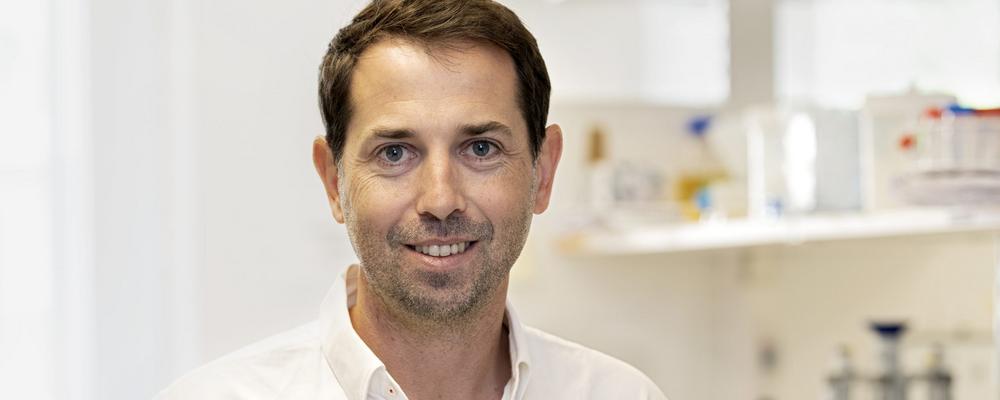
- Home
- News and events
- Find news
- Wallenberg Centre biophysicist seeks markers for diabetes
Wallenberg Centre biophysicist seeks markers for diabetes
Joan Camuñas-Soler, the newly appointed Assistant Professor in Bioinformatics for Translational Medicine, has his own research group at the Wallenberg Centre for Molecular and Translational Medicine (WCMTM). In his research, he combines diagnostics, computer science and biophysics to find new biomarkers, currently for metabolic disorders such as diabetes in particular.
His Lundberg Laboratory office gives an airy, unadorned impression — hardly surprising, since he has held his research position in Gothenburg for less than six months. So far, his research group consists only of himself and a postdoctoral researcher, but it is set to expand this fall.
Enticed by the unexpected
The research is about, first, finding new, complex biomarkers for disease and, second, developing new “single-cell” methods to study cell activity and provide new means of surveying conditions when the cells are not working as they should.
“We’re interested in understanding how cellular heterogeneity arises within human cell types, and to how far messenger RNA (mRNA) reflects the physiological state of the cell. My lab’s now focusing on metabolic disorders like diabetes, but I also want to explore other systems where single-cell genomics and data-driven approaches can reveal unexpected biology,” Camuñas-Soler says.
For him, unexpected findings are a vital research driver. He states that he is more fascinated than discouraged when things turn out to work differently than his original hypotheses.
“More often than you might think, a hypothesis doesn’t seem correct. So I want to understand what’s going on and the actual workings. Sometimes, that leads to really interesting discoveries,” says Camuñas-Soler, whose goal is to establish himself as a leading genomics and biophysics researcher.
Computer science in biomedicine
His research data is generated using human tissue provided by clinical collaborators, in cell cultures in the lab, or through contributions from large, accessible research databases. With machine learning, Camuñas-Soler creates algorithms that can help create order among signals from thousands of different RNA molecules.
“Many of the mRNA signals we measure contain physiological information that we want to quantify, but there’s also a tremendous lot of noise. Using computer science, we can distinguish the important signals and find patterns that can be linked to functions in cells, or to various diseases,” he says.
His techniques have the potential to be applied in many fields. He has already succeeded in setting up collaborations both with Anders Rosengren, in diabetes research, and with Assistant Professor Aishe Sarshad, another WCMTM scientist, who is researching Argonaute proteins.
Noninvasive diagnostics
Camuñas-Soler started off as a physicist, educated in his home city, Barcelona. After a master’s degree in biophysics at KTH Royal Institute of Technology in Stockholm, he returned to Barcelona for graduate studies, specializing in molecular biophysics and single-cell genomics. While holding a postdoctoral position at Stanford University, California, in a group led by Stephen Quake, he developed new noninvasive diagnostic tools, based on single-cell genomics and mRNA analyses, to investigate metabolic disorders and pregnancy complications. These advances were the start of a new company for Quake, the research leader, where Camuñas-Soler served as First Scientist for a few years. Work in the group and company has recently culminated in several high-quality scientific publications.
Attractive offer
Since May 2022, Camuñas-Soler has been Assistant Professor at the Institute of Biomedicine, recruited in WCMTM.
“I wanted to come back to Europe, where my roots are, and started looking for potential scope to start my own lab. The WCMTM offer was great and I got a good impression of the opportunities at the Institute and the research environment I’d belong to,” he says.
He notes that there is now a critical mass of clever young researchers at the University of Gothenburg, thanks in part to the WCMTM investment.
Loves the sea
As a distinctly “big-city” person, having previously lived in cities such as Barcelona, Stockholm, and San Francisco, he initially doubted whether he could thrive in one of Gothenburg’s size. However, his new hometown has proved to meet all his needs more than well.
“Gothenburg is big enough to have a good cultural offering, and cozy cafes and breweries, but at the same time small enough for you always to be close to nature. The cities I’ve lived in before have all been near the coast. Having the sea close by is something else I really appreciate about Gothenburg,” says Camuñas-Soler who, in his spare time, enjoys both kayaking and exploring the coastline by bike.
BY ELIN LINDSTRÖM

